Wageningen professor Niels Anten (Centre for Crops Systems Analysis) has solved part of this riddle. Together with a group of Japanese researchers, Anten carefully monitored how much light trees capture and what they do with it. This was done in a section (60×20 metres) of primary temperate rain forest on the island of Yakushima, a national park and world heritage site. The growth rates of the 24 species of tree in this small area were measured and correlated with the characteristics of their leaf crowns.
Less efficient
The result is remarkable. Not only do tall trees capture more light, they also do so more efficiently. Per kilo of biomass, tall trees capture more light than their overshadowed cousins. But this advantage comes at a price: they are less efficient at converting this light into biomass. Light capture and light use are in inverse proportion to each other. This so-called trade-off ensures that, in relative terms (per kilo of tree), small trees and tall ones grow equally fast.
And this is news. According to Anten, it goes a long way towards explaining why small and tall trees can live side by side in places where there is ‘unfair’ competition for the available light. ‘There are other important factors besides that, such as the population dynamics (number of offspring, lifespan) and the structure of the forest. But growth is a very important one, of course.’
You could take ideas from this for agriculture, thinks Anten: ‘In the plant breeding world there is a strong focus on monosystems. But through the heavy use of pesticides, such systems are coming under increasing pressure. The ecology shows that it is precisely mixed and diverse systems that are more productive and stress-proof. We can learn a great deal from natural systems. Studies such as ours show what kinds of characteristics overshadowed plants need in order to produce optimally.’

